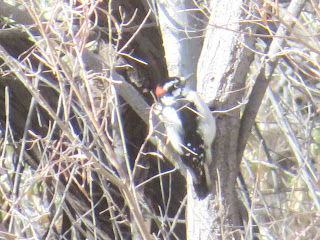Every rural place has a beauty to it, but New Mexico is pretty awesome
for wide vistas, both on the mesa or in the bosque. Seeing the sunrise over the Sandia mountains is quite a
spectacle, especially with Canada geese honking from a cold, steaming river before
the noise of the human commute begins to shake them out into the grazing
fields nearby
Avian influenza has been spreading down the continental US from the North-east this year. New Mexico has found only 1 case in a cinnamon teal duck in Bosque Del Apache, so far. However, it is more likely this animal died as a result of trichomoniasis, avian pox, or salmonella. Bird feeders are common sources of bacterial infections in doves. Even if a dove survives to adulthood, there is a 60% mortality rate.Coots, or "water chickens" are usually feeding on plants during the winter. This one is feeding voraciously on duckweed, which is a very cold tolerant, and is not algae, but rather one of the smallest species of flowering plants in the world. This frenzied feeding suggests this bird is a recent migrant to Corrales but their migration patterns are poorly understood.
I think this is a hairy woodpecker. These genus of birds tend to stay in an area year round and their numbers are supported by the blocks of of suet that are put out on winter bird feeders.
The flicker is another type of woodpecker that has adapted to feeding on burrowing insects found on the ground, such as termites or beetles. New Mexico also has sapsuckers, which are another type of woodpecker that can sometimes drink tree sap, but they tend to be found at higher elevations. As always, the number of sites dedicated to treating woodpeckers as pests far outnumber those that talk about their benefits. However, in this case, the "treatment" for nuisance woodpeckers appears to be put up suet blocks in the winter, and build nest boxes as an alternative to drilling holes in houses and trees. Humm, pays to have federal protection.
There are not many insects around right now, however the afternoon brings out small flying insects and there are still many hunting spider species prowling during the day like this grass spider.Coyotes are very misunderstood, and some people know this. However, the details are still interesting. The coyotes of Corrales appear to prefer grapes and apples when they are available, according to their abundant scat that they leave along prominent trails. They also hunt for mice in the pre-dawn hours and after ditch mowing by the MRGCD along the ditches. Research conducted by Santa Ana Pueblo shows they are a common prey item by mountain lions, so they are always nervous when alone, just like people. While they are not wolves by any means, they do not turn down an opportunity to snack, such as a sick bird.
Birds flock together in the evening to roost for protection from all predators. Most water fowl like ducks, geese and cranes spend the night on sand bars in the open river where it is impossible for a predator to either sneak up, or rush them, before being seen. As the sun rises, the birds become increasingly anxious to unexpected sounds until they alight into the air as a group and head out to an open space with either a lot of open space, or fences, to feed. You'll notice the birds are all looking in different directions to assess for danger. If they are all looking in the same direction, then you should be, too.
The MRGCD is responsible for maintaining the integrity of flood defenses and supply of irrigation water to farming communities in Corrales, but it is everyone's responsibility to look after the preserve. While the Bosque is a fascinating place, it is best explored by foot, bike, or horseback. An open gate like the one shown here is not an invitation to bring a vehicle onto the preserve and is only used to perform ditch maintenance activities.
Most people know they should not drive in the bosque, but there is still a strong desire in most of us to want to explore new places. If we have a comfy chair inside a steel box with heating and cup holders, all the better.









No comments:
Post a Comment